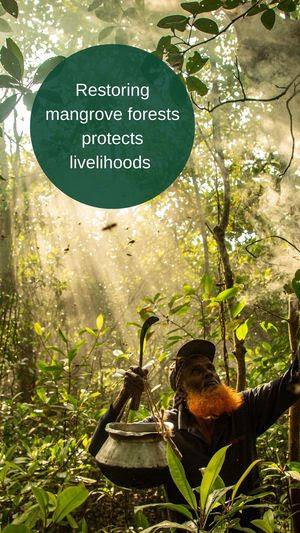Mangrove NewsAn Appeal from our Executive Director for the Mangroves
Maybe world leaders are finally reading the writing on the wall?
Maybe they finally understand that the recent frightening weather, massive forest fires, droughts and floods are not just chance occurrences but due to our planet-level experiment of increasing CO2 levels from the pre-industrial 280ppm to 415ppm today. There’s no argument about these numbers or the greenhouse gas effect – it’s just straight physics. We can debate the link between CO2 levels and climate change. Or we can take practical action now.
Please support MAP to do what the world should be doing, climate change or not – conserving existing mangroves and restoring degraded forests, as fast as possible.
Why mangroves in particular? Because they form an amazing intertidal ecosystem that provides all sorts of benefits, local and global, but are under threat from shrimp farming, urban development, road building, sea walls, oil palm expansion, sea level rise and other challenges. Such benefits as storing up to five times the amount of carbon per unit area compared to tropical rainforest, and providing a home for a great biodiversity of plants and animals, big and small. Benefits for coastal communities including protection from violent weather, storm surges, waves and sea level rise. And benefits that allow coastal folk to live a sustainable life, put a roof over their heads and enjoy food security. 
Many of you have supported MAP in the past, for which a million thanks. What do we do with this money and why do we need further support at the end of 2021? 1980s development history demonstrated that global NGOs like MAP should not just rush into a coastal region and implement projects, paying local people for their labour. Projects managed this way are bound to fail. We believe in building the local capacity of coastal stakeholders such as villagers and government field office staff so they can manage and run their restoration projects successfully, and fully understand the vital importance of conserving their existing mangroves. In addition, our ‘Marvellous Mangroves’ program teaches students the value of their local mangroves, ensuring the next generations value and protect these amazing ecosystems. Both these programs take a dedicated, highly skilled and qualified team to instigate and deliver these training programs.
Furthermore, the mangrove world is a wide one with many different audiences operating at all levels, from CoP meetings to local village-level implementation. Therefore, we don’t just teach but also run an awareness-raising photography competition and a children’s mangrove art competition – now in its 20th year – all boosted by a very active social media presence. We continue to be central to, and advise, several mangrove related groups such as the IUCN Mangrove Specialist Group, the Global Mangrove Alliance, the UN’s Decade of Ecosystem Restoration, and the mangrove advisory group to the World Economic Forum. We advise NGOs and companies that get in contact with MAP to improve their restoration outcomes. To keep MAP engaged with the academic world, staff both review and contribute to research papers with various academic collaborators. We do all this to push the mangrove agenda as hard and effectively as we can, as many would argue that we have approximately 10 years to address the climate warming crisis. Mangroves will play an important role in the solution, but they will need our help.
MAP is blessed by having a passionate, experienced, highly qualified and loyal team. We need funding to run more capacity-building and outreach programs, and advocate for mangroves at conferences and meetings such as COP26. You can help us to increase MAP’s impact by donating to MAP now. Thank you for all your assistance and support through the years.
Yours sincerely,
Dominic Wodehouse
Executive Director, MAP


